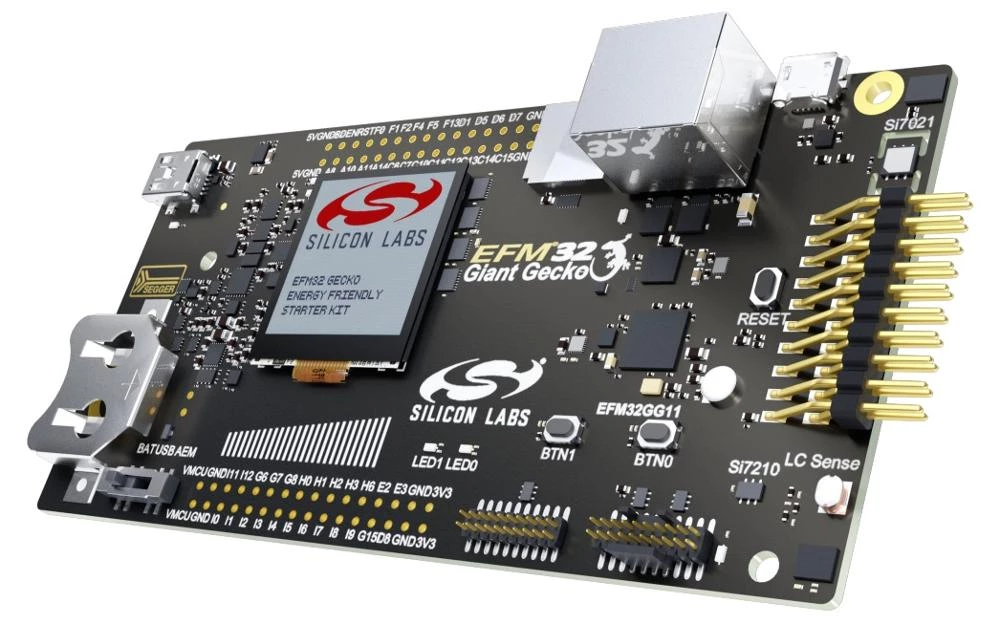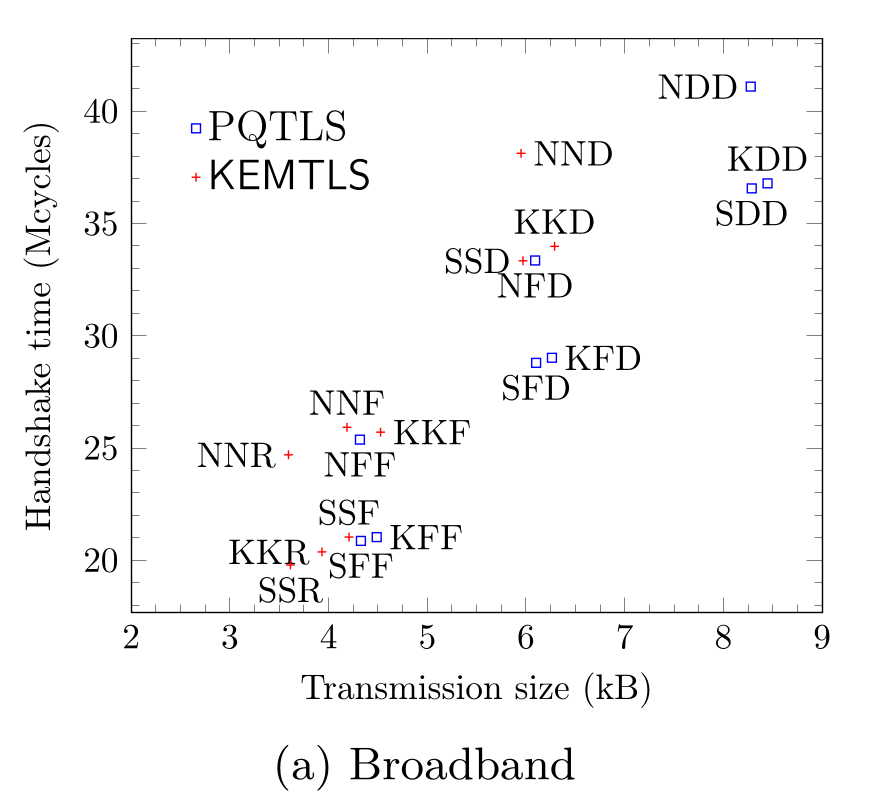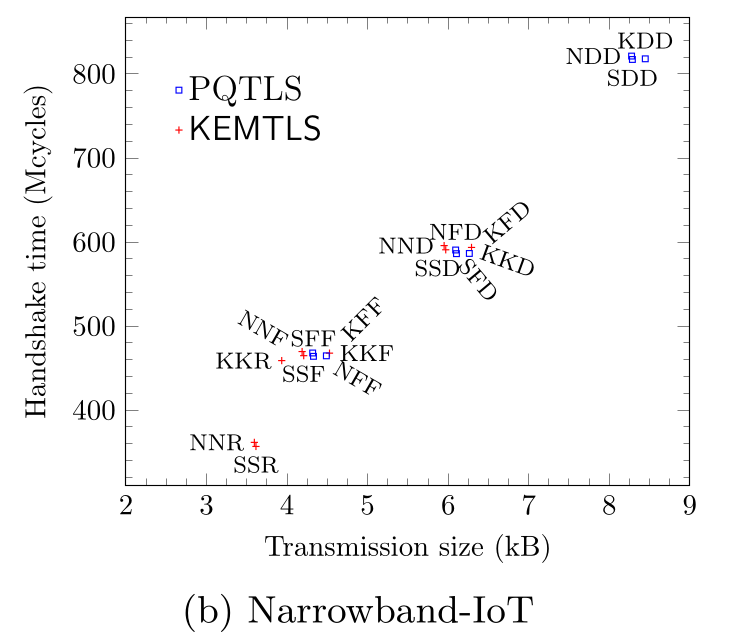KEMTLS vs. Post-Quantum TLS
Performance on embedded systems
Ruben Gonzalez and Thom WiggersPost-Quantum

Quantum attacks on cryptography
- Quantum computers are not generally faster
- Shor's Algorithm specifically efficiently solves factoring and discrete log problems
- Need new cryptographic primitives to replace them
NIST PQC competition
Key Exchange
- Kyber ⭐
- SABER
- NTRU
Signatures
- Dilithium ⭐⭐
- Falcon ⭐
- Rainbow 🪦
- SPHINCS+ ⭐
KEM key exchange
sequenceDiagram
Alice->>Bob: public key
Note right of Bob: shared secret, ciphertext = KEM.Encapsulate(pk)
Bob->>Alice: ciphertext
Note Left of Alice: shared secret = KEM.Decapsulate(sk, ct)
Note over Alice, Bob: encrypt traffic with shared secret
Tradeoffs
KEMs
- Fast
- Smallish
Signatures
- Dilithium: huge pk, signature
- Falcon: FPU usage in signing
- Rainbow: enormous public key, tiny signature
Q: how can we best use these tradeoffs?
Post-Quantum TLS
sequenceDiagram
Client->>+Server: ClientHello: ephemeral kex
Server->>-Client: ServerHello: ephemeral kex
rect rgba(0,0,0,0)
Server->>Client: Certificate: static signing pk
Server->>Client: Signature
end
Server->>Client: ServerFinished
rect rgba(0, 0, 0, 0)
Server-->>Client: Application Data
end
Client->>Server: ClientFinished
Client-->>Server: Application Data
sequenceDiagram
Client->>+Server: ClientHello: ephemeral kex
Server->>-Client: ServerHello: ephemeral kex
rect rgba(2, 100, 2, 0.3)
Server->>Client: Certificate: static signing pk
Server->>Client: Signature
end
Server->>Client: ServerFinished
rect rgba(0, 0, 0, 0)
Server-->>Client: Application Data
end
Client->>Server: ClientFinished
Client-->>Server: Application Data
sequenceDiagram
Client->>+Server: ClientHello: ephemeral kex
Server->>-Client: ServerHello: ephemeral kex
rect rgba(0, 0, 0, 0)
Server->>Client: Certificate: static signing pk
Server->>Client: Signature
end
Server->>Client: ServerFinished
rect pink
Server-->>Client: Application Data
end
Client->>Server: ClientFinished
Client-->>Server: Application Data
- Ephemeral KEM key exchange
- Signature public key in certificate
- Server can send data immediately
KEMTLS
sequenceDiagram
Client->>+Server: ClientHello: ephemeral kex
Server->>-Client: ServerHello: ephemeral kex
rect rgba(0,0,0,0)
Server->>+Client: Certificate: static KEM pk
Client->>-Server: Ciphertext
end
Client->>Server: ClientFinished
rect rgba(0, 0, 0, 0)
Client-->>Server: Application Data
end
Server->>Client: ServerFinished
Server-->>Client: Application Data
sequenceDiagram
Client->>+Server: ClientHello: ephemeral kex
Server->>-Client: ServerHello: ephemeral kex
rect rgba(2, 100, 2, 0.3)
Server->>+Client: Certificate: static KEM pk
Client->>-Server: Ciphertext
end
Client->>Server: ClientFinished
rect rgba(0,0,0,0)
Client-->>Server: Application Data
end
Server->>Client: ServerFinished
Server-->>Client: Application Data
sequenceDiagram
Client->>+Server: ClientHello: ephemeral kex
Server->>-Client: ServerHello: ephemeral kex
rect rgba(0, 0, 0, 0)
Server->>+Client: Certificate: static KEM pk
Client->>-Server: Ciphertext
end
Client->>Server: ClientFinished
rect pink
Client-->>Server: Application Data
end
Server->>Client: ServerFinished
Server-->>Client: Application Data
- Ephemeral KEM key exchange
- KEM public key in certificate
- Avoid extra round-trip by letting client send data immediately
Existing work:
- Server-only and client authentication
- Proofs, Tamarin analysis
- Variant with pre-distributed keys
- Benchmarks using large-scale computers
Embedded devices

Silicon Labs STK3701A "Giant Gecko"
| CPU | 72 MHz Cortex-M4F |
|---|---|
| FPU | ✅ |
| Flash | 2 MB |
| SRAM | 512 kB |
| Giant? | Definitely. |
The network
| Abbrev. | Protocol | Link speed | RTT |
|---|---|---|---|
| BB | Broadband | 1 Mbit | 26 ms |
| LTE-M | LTE Machine Type Communication | 1 Mbit | 120 ms |
| NB-IoT | Narrowband IoT | 46 kbit | 3 s |
Implementation
- WolfSSL client on Giant Gecko
- Rustls server on desktop computer
- Ethernet connection
- Apache Zephyr RTOS
Results
Code size results
- Both KEMTLS and PQTLS need key exchange and signature verification code
- (KEM)TLS clients do not need signing code
- Large differences in sizes of necessary certificate authority (CA) public keys: KEMTLS certs slightly smaller
- PQTLS mixed certificate chains require more code
- KEMTLS peak memory usage is lower
Communication time
- KEMTLS handshake traffic generally much lower
- KEMTLS: Kyber-Kyber-Dilithium: 6.3 kB
- PQTLS: Kyber-Dilithium-Dilithium: 8.4 kB
- Less traffic = faster handshake on low-bandwidth connections
- PQTLS with Falcon certificates still very fast
- Falcon is very small
- Falcon verification very fast on Cortex-M4F
- Requires Falcon online signing on the server


Wrap-up
KEMTLS vs. Post-Quantum TLS: performance on embedded systems
Conclusions
- KEMTLS saves bytes on the wire, which really matters
- Without client authentication no big code size differences
- Paper at https://kemtls.org/.
Future work
- Client authentication
- KEMTLS with Pre-Distributed Key
Thanks for your attention